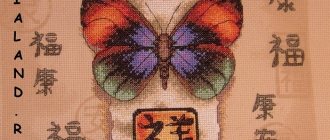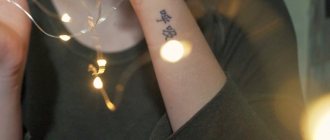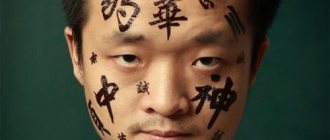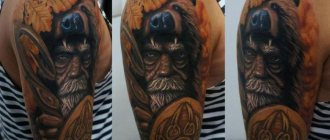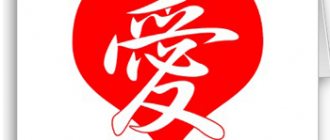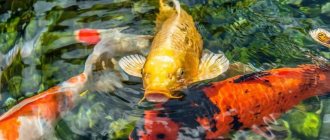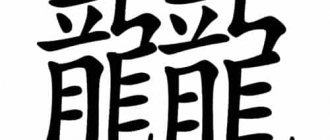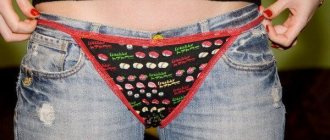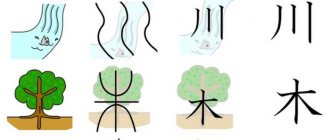There are several categories of people who get hieroglyphs tattooed on themselves. Some are lovers of Asian culture. Others - because you can hide the meaning of a tattoo, unlike a regular design. Still others believe in the mystical meaning of this amulet. Well, the fourth ones are just for beauty.
In any case, there are quite a lot of such people, both among men and women. If you are one of them, then this article is just for you. Here we will talk about the meaning of various hieroglyphs, translate them into Russian and show examples of ready-made tattoos on all parts of the body.
Chinese tattoo characters about feelings: ideas, photos, meanings
Love . Chinese tattoo characters about feelings are in principle very popular, and the sign of love is the most common of them. It consists of such components as “claws”, “veil”, “heart”, “friend”. After all, this feeling clings tightly to our heart and covers it. Moreover, true love includes friendship.
IMPORTANT: It is believed that this tattoo helps to bring peace and happiness into relationships.
Hieroglyph for a tattoo that means the most wonderful feeling
This is what the Eternal Love tattoo looks like on the body
. Depicts that very “love to the grave” that every person dreams of. The sign indicates that support and mutual understanding for the owner of the tattoo and his significant other is not an empty phrase.
Tattoo with a sign of eternal love
Tattoo with this hieroglyph
Joy . It is believed that such a tattoo helps to always be in a good mood. And, most importantly, keep it for as long as possible. An excellent option for people who dream of finding harmony in their souls.
Hieroglyph meaning joy for tattoo
Sincere faith. This is the feeling that sometimes helps people survive even in difficult conditions. The tattoo just testifies to such optimism in its owner. And helps strengthen it.
A hieroglyph suitable for those who want to talk about their faith
Double Happiness. Great idea for a couple tattoo. It will indicate harmony in relationships and help implement joint plans. And if your soulmate doesn’t exist yet, such a sign will help you find her.
Tattoo hieroglyph double happiness
A tattoo with the hieroglyph of double happiness looks very elegant on the body
On the back and spine
Since the back is a very large area, it would be stupid to fill it with just a Japanese character. But they can be stuffed on the lower back, on the shoulder blade or under the neck. Usually this is just a tattoo option for girls.
Men, as in the case of the sternum, fill a part of the body with a large-scale design that includes hieroglyphs. Or they get a tattoo with Japanese or Chinese symbols along the spine.
Chinese tattoo characters about character: images, interpretation, ideas
Wisdom. Like many Chinese tattoo characters, this sign consists of several meanings. This is knowledge and understanding , as well as consistency . In other words, the Chinese understand the concept of “wisdom” as daily development.
IMPORTANT: They also extremely value wit, which is also attributed to the specified term.
Tattoo symbolizing wisdom
Kindness. Chinese tattoo characters have an extremely interesting history, especially this icon. It consists of two very unexpected parts - “sheep” and “speech” . The fact is that the Chinese divided sounds from animals into evil and good. The bleating of a sheep was associated with kindness, because this animal is always docile and peaceful.
Hieroglyph kindness for tattoo
Moral. This hieroglyph is also called “de” . One part of the hieroglyph symbolizes foot , his steps - that is, actions. The other is the many eyes of a deity that look deep into the human heart.
A hieroglyph for a tattoo that speaks of a person’s strong morality
Mercy. The hieroglyph consists of two parts - love and pity . It is noteworthy that in both the first and second parts there is a component meaning heart. The Chinese believed that true mercy comes from the deepest hearts. It's not something that's on display!
Hieroglyph for tattoo meaning mercy
Courage. This sign is also composite. Its upper part signifies a person with a brave heart, as well as courage. Bottom - influence, power.
Hieroglyph for tattoos for brave people
Which salon should I go to?
There are a lot of salons that will kindly provide tattooing services, including Chinese characters. But everyone who wants to wear such beauty on their body must still adhere to certain precautions.
What you need to do:
- Make a preliminary plan or drawing of the image that is preferred.
- Compare the sketch with several analogues on the Internet.
- Read as much information as possible about its meaning.
- Consult with several experienced tattoo specialists. It is desirable that they are not just masters, artists, but well versed and understand the art of the East.
- It is advisable to talk with clients who had hieroglyph tattoos done by this artist, what opinion they had about the work, and whether they were satisfied with the end result.
Make a preliminary plan or drawing of the image you prefer Compare the sketch with several analogues on the Internet
Find as much information as possible about its meaning.
What you should absolutely not do:
- Choose a tattoo artist who, in addition to oriental art, specializes in a number of genres. A good master is one who devotes all his time to one profile and his calling - oriental art. In fact, he should have no free time for other genres, nor, indeed, any desire.
- Getting a tattoo without thinking, just for fun. The East does not tolerate thoughtlessness and frivolity. Many hieroglyphs are very similar to each other, so it’s very easy to make a mistake here; correcting a mistake will be harder, more painful and more expensive.
Consult with several experienced tattoo specialists. It is desirable that they are not just masters, artists, but well versed and understand the art of the East
It is advisable to talk with clients who have had hieroglyph tattoos done by this artist, what opinion they have about the work, and whether they were satisfied with the end result
A good master is the one who devotes all his time to one profile and his vocation - oriental art
Chinese tattoo characters about professions: ideas, meanings, photos
Military. Chinese tattoo hieroglyphs, indicating that their owners belong to the military profession, can often be found. The hieroglyph consists of icons such as "spear" and "stop". The Chinese perceived warfare primarily as self-defense, not attack—hence the similar terminology.
IMPORTANT: If you look closely at the icon, you will notice that it also includes the word “art”. The creative eastern people truly perceived such craft as a type of art.
Tattoo ideal for military
Lawyer, law enforcement officer. The hieroglyph meaning “law” . Previously, its outline was quite complex, but now a more simplified version is in use.
It consists of strange parts at first glance - “water”, “unicorn”, “leave”. However, everything is understandable: the surface of the water is associated with impartiality, and legends endowed the unicorn with the ability to determine who is honest.
Hieroglyph for a tattoo that means law
Doctor. People of this profession can mark themselves with the hieroglyph “medicine” . It consists of the following components - “quiver with arrows”, “hand with hook”, “dishes for alcohol”.
The fact is that previously triangular arrowheads were difficult to pull out. And they often dug into the bodies of warriors. To solve the problem, doctors used hooks. And the wound and hook were disinfected with alcohol. It was also a means of anesthesia.
Hieroglyph for tattoos for doctors
On the hand
The hands are in second place after the neck. Hieroglyphs are tattooed on the shoulder, forearm, and wrist. Yes, they even do it on the hands and fingers, but less.
Tattoos with names and life mottos in Chinese or Japanese would look appropriate in these places.
Chinese tattoo characters about hobbies: meanings, photos, ideas
Music. Music lovers can expect their own Chinese tattoo characters. For example, in the form of a flute. In China, such instruments were once made from bamboo , which, in fact, is what the upper part of the hieroglyph means. The second component means “to guide.” That is, it is understood that melodies guide our thoughts and allow us to think about something important.
IMPORTANT: This tattoo is also perfect for those people who play music professionally.
Hieroglyph tattoo in the form of a flute
Creating jewelry. Had-made jewelry is extremely popular, and creating them is addictive. Why not perpetuate your favorite pastime? The appropriate hieroglyph consists of the roof sign - this is a house. There are also icons of jasper and amphora, where it was customary to put it. There is also a “shell” - it was previously extremely valued.
Hieroglyph for tattoos for crafters
Acting skills . Home theaters were previously very popular, but even today this type of leisure has a lot of fans. Some people also like to take acting classes for themselves. For such people, the “ image”, “likeness” . Tattoos are simply a godsend for those whose hobby is achieving maximum resemblance to someone or something.
Hieroglyph for tattoos for fans of acting
Fictional examples[edit]
- Halo - Precursor Glyphs.
- Battle Engine Aquila - Forsetti hieroglyphs, the decoding of which can be found in additional materials.
- Lovecraft loved
to give all sorts of intelligent supernatural horror such squiggles. - The Lord of the Rings - in Muravyov’s translation, the “vile Mordorian symbols” are called hieroglyphs. Why not?
- "Legacy" by Christopher Paolini - Elves use hieroglyphic writing.
- I. Efremov, “Hour of the Ox” - the writing of the planet Tormans is similar to Chinese characters and, perhaps, originated from them.
- The Stargate franchise is the writing of the Ancients and the Goa'uld (hidden from the Ancients, by the way).
- Dancing with Aute with a screwed wick - sen-images, not so much hieroglyphs, but energy symbols that are part of non-human facial expressions.
- Nickelodeon's Avatar - Partially True Ancient Chinese Characters.
Chinese tattoo hieroglyphs talismans: meanings, photos, options
Abundance. Chinese tattoo hieroglyphs, which help to attract something or protect from something, are extremely popular. And the hieroglyph meaning abundance breaks all records. Even among the Chinese, wealth is one of the main wishes for the holidays.
The hieroglyph consists of such parts as “house”, “mouth” and “field”. That is, shelter, food and a source of food. Basic needs are what the Chinese understand as abundance.
IMPORTANT: Abundance in Chinese means nothing extra. Only the basics, but in a satisfactory quantity.
A hieroglyph illustrating wealth is great for a tattoo. This is how this hieroglyph looks like a tattoo on the body
of Buddha. An extremely strong person in Chinese culture and therefore a powerful talisman. His interpretation is curious - Buddha consists of the element “man” and the particle “not” . That is, divine origin is emphasized. It is believed that the talisman helps to improve oneself and find enlightenment.
Hieroglyph tattoo in the form of Buddha
Longevity. One of the most important wishes of the Chinese. It is interesting that this hieroglyph comes from the word “field”. Then the "elderly" icon was added . The eastern people were sure that doing manual labor and eating natural food was the key to long life.
Talisman tattoo meaning longevity
Luck. This hieroglyph consists of the symbols "sage" and "speech". In other words, luck is not just fatalism, luck. This is working on yourself. And the ability to listen to the sages, the desire to follow their advice.
Hieroglyph tattoo meaning good luck
On the stomach and chest
On the torso, the location for a tattoo usually depends on gender. Girls prefer to beat hieroglyphs on the collarbones, under the breasts or on the side and ribs. The latter, by the way, are a great place for some big quote or a long clever phrase, the meaning of which only you will know in Russian.
Guys choose the area on the chest or stomach. You don’t often see a hieroglyph tattoo on these parts of the body. Usually it is stuffed together with some kind of Japanese-style pattern.
By the way, for those who are interested, it is almost impossible to find hieroglyphs on intimate parts of the body. They don't beat them there.
Chinese philosophical tattoo hieroglyphs: photographs, interpretation, ideas
Eternity. Chinese tattoo hieroglyphs often tell us about something immutable that makes us think. In ancient times, this hieroglyph was drawn as a stream of water.
INTERESTING: It is considered a rather difficult hieroglyph to write. They say that whoever mastered it also mastered the Chinese art of writing.
A hieroglyph meaning eternity - fans of the tattoo
Awareness and understanding are very fond of it. It combines the signs “soul” and “I”. The latter, in turn, comes from “awakening”. That is, complete awareness of something, in the Chinese understanding, is the awakening of the soul. A tattoo helps you to renounce as much as possible from the worldly, to improve your heart.
A hieroglyph for a tattoo that will mean awareness of something
Thought. This hieroglyph has an interesting history. It consists of such parts as “voice” and “heart” . The decoding is as follows: a truly sound thought comes from the heart.
Once upon a time, the hieroglyph was written differently, being composed of the concepts “skull” and “heart”. It was believed that the soul lives in the heart, and its doors are in the head. That is, thoughts and souls in the east were connected together.
Tattoos for thinking people
Birth and death. These are two completely different hieroglyphs that should be placed side by side. The tattoo is suitable for people who often think about the finitude of life, the meaning of existence.
Birth is literally a sprout that breaks out of the ground. And death is depicted in the form of a man bending over the deceased .
Tattoo with a hieroglyph meaning birth
Tattoo with a hieroglyph meaning death
What Chinese characters look like, how to distinguish them from Japanese, Korean, etc.
For a non-professional or someone who does not know any of these languages, it is almost impossible to distinguish between them. If you really want to distinguish, at least visually, then you can listen to a few tips:
- The Hangul alphabet is Korean. It is characterized by a large number of circles and ovals. Straight lines are also often used. For example: 사, 기쁨, 운, 세계, 헌신, 충, 인내. The Korean language is more expansive than Chinese and Japanese.
- To find a text in Japanese, you need to remember its three main elements, which are called katakana, kanji, higarana. Many characters in Japan are also round, but they are characterized by a slight carelessness in writing. An example is the Japanese characters: 愛, 喜び, 運がいい, 世界, 献身, 慊つキツ。, 我慢. When recognizing the Japanese language, take into account that some characters were taken from Chinese, and they, in turn, are more encrypted and complex.
Chinese tattoo hieroglyphs about natural phenomena: meanings, ideas, photos
Morning evening. Chinese tattoo hieroglyphs have always attracted romantic people. They are especially interested in this combination. The morning hieroglyph consists of an icon, in fact, of the sun itself, as well as a symbol of a burst seed skin. In the evening everything is just as logical – there are icons of the sun and running away.
IMPORTANT: For dreamers who love to watch sunrises and sunsets, such a tattoo will be very appropriate.
Hieroglyph for a tattoo meaning morning
Hieroglyph for a tattoo meaning
Spring evening. The tattoo is ideal for those people who want to highlight the renewal in their lives. Or just those who adore this time of year. The Chinese, by the way, are very fond of this hieroglyph. It consists of the grapheme of a newly hatched plant, grass and sun.
Chinese character for tattoo meaning spring
Autumn. It is also a romantic time, as well as a fruitful one. The hieroglyph consists of the grapheme “cereals”. There is also a “fire” symbol, since the stems remaining after harvesting were burned. In addition, the grapheme “fire” is similar to “cricket”. These melodious insects are also associated with the autumn season, as this is when they love to sing.
Hieroglyph for a tattoo meaning autumn
Clear sky. The Chinese were very fond of this phenomenon, comparing smart people with it, for example. The highest degree of recognition sounded like “son of heaven” - that’s what the emperor was called. The hieroglyph looks like a man with his arms outstretched, above which is the sky.
Hieroglyph for a tattoo that means clear sky
On the neck and head
According to statistics, most often hieroglyphs are tattooed on the neck. I think many people have met people with the symbol of the Chinese horoscope stamped on this place. You can rarely find such tattoos on the head itself. The only exception is a woman's favorite place - behind the ear.
Also, facial tattoos have become fashionable lately.
You can already meet a character with an oriental symbol above the eyebrow or under the eye.
Chinese tattoo characters about flora: meanings, photos, ideas
Tea leaf. Chinese tattoo characters can even immortalize your favorite drink. An example of this is tea, which is equally adored by both our compatriots and Easterners. It is believed that it not only gives a pleasant taste, but also relieves the blues and improves health. This hieroglyph is double - it directly symbolizes the tea itself and the leaf.
IMPORTANT: It is believed that such a tattoo will give good spirits.
Hieroglyphs for tattoos about tea
Flower. A very gentle symbol that girls will certainly like as a tattoo. It will be synonymous with prosperity, spring, love and beauty.
Hieroglyph tattoo in the form of a flower
Sakura . One of the most ancient and revered symbols. Sakura blooms very beautifully, but it does not last long. This shows us that it is necessary to appreciate every moment allotted by fate.
Hieroglyph for tattoo - sakura
Rose. Quite an impressive hieroglyph. youth in China . However, surprisingly, it is not associated with love. It is recommended to apply the hieroglyph to young girls who want to emphasize their blooming beauty.
Hieroglyph for rose tattoo
Tree . The hieroglyph depicting it really looks like a trunk and branches. It is considered one of the most used signs. The tree was seen as a mediator between heaven and earth, a kind of support. It was also perceived as a symbol of life.
In this picture for a tattoo it is clear why the tree hieroglyph has such outlines
Other Chinese characters with translation into Russian
A few characters that can help in everyday life in China:
- 喜喜 – double happiness
Double Happiness
- 寿 – longevity
Longevity
- 尊重 – respect
Respect
- 禄 – prosperity
Prosperity
- 永恒 – eternity
Eternity
- 智慧 – wisdom
Wisdom
- 自豪 – pride
Pride
- 力 – strength
Force
- 朋友 – friend
Friend
- 能源 – energy
Energy
- 美 – beauty
beauty
- 自由 – freedom
Liberty
- 梦 – dream
Dream
- 风 – wind
Wind
- 希望 – hope
Nadezhda
- 和平 – peace and harmony
Peace, harmony
- 福 – fortune, luck
Luck
- 命运 – fate
Fate
- 忠诚 – loyalty, devotion
Devotion
- 勇气 – courage, valor
Courage, valor
Chinese tattoo characters about the animal world: meanings, photos, ideas
Turtle. One of the sacred creatures in China. Local residents believe that it was the turtle that inspired Tsang Jie, the historiographer of Emperor Huangdi, to create writing in the form of hieroglyphs.
INTERESTING: The Chinese can see various objects in the interweaving patterns on a turtle’s shell. This is reflected in the interlacing lines of the hieroglyph.
Hieroglyph for a tattoo depicting a turtle
Deer. One of the most favorable symbols. Associated with renewal, purity, sun, spirituality. The fact is that the horns of this animal are perceived by the Chinese as synonymous with the tree of life.
Hieroglyph for a tattoo depicting a deer
Cat. of elegance, cunning, grace, lightning speed, and comfort beloved by many And also the ability to walk on his own. By the way, the hieroglyph demonstrates this. After all, literally “cat” means “an animal walking in the grass.”
Hieroglyph for cat tattoo
Bear. A very interesting hieroglyph. It consists of parts such as “to be able to” and “fire”. This is an indicator that this beast can do anything. He stands guard and helps achieve goals. Moreover, for our latitudes such an animal is very symbolic.
Hieroglyph for a bear tattoo
A LITTLE ABOUT APPLIED SCIENCE
SYMBOLS AND SIGNS IN TATTOOS
Interest in Eastern culture in modern society is increasing year by year. Tattoo parlors are becoming increasingly popular, where you can get a tattoo in the form of an oriental ornament or a hieroglyph. Classic oriental dragons, fish, cranes, pandas, plants (for example, lotus - a Chinese symbol of purity and chastity, bamboo - a Japanese sign of the new year). Mysterious and beautiful Asia reveals its secrets to us. China and Japan provided abundant food for the imagination of authors when creating plots and patterns. Along with ornaments, tattoos with hieroglyphs, which are various symbols, have become widespread.
Hieroglyph "love"
Hieroglyph "happiness"
Hieroglyph “luck” Hieroglyph “strength” Hieroglyph “wealth”
Hieroglyph "dragon" Hieroglyph "money"
Hieroglyph “life” Hieroglyph “health”
Hieroglyph "freedom"
Hieroglyph "friendship"
Hieroglyph "path"
Hieroglyph “fire” Hieroglyph “wisdom”
NAMES IN JAPANESE HIEROGLYPHS
Russian names in Japanese modification sometimes sound very strange and unusual for perception. Let’s say Anatoly sounds like “Anatori” in Japanese and translates to “hole, bird.”
Female names:
| Alexandra Arekkusandora |
| Angelica Anzuheraika |
| Antonina Antonina |
| Valentina Varentaina |
| Victoria Vikkutooaiya |
| Galina Garaina |
| Daria Derya |
| Evgenia Evuzenaiya |
| Elena Irena |
| Elizaveta Eraizaveta |
| Irina Iraina |
| Ksenia Kusenaiya |
| Love Rubavvu |
| Lyudmila Radomaira |
| Maya Mea |
| Maria Meraiya |
| Nadezhda Nadezuda |
| Natalya Neterya |
| Olga Oruga |
| Svetlana Suvetorena |
| Tatiana Techiena |
| Julia Juraiya |
Male names:
| Alexander Arekkusandoru |
| Alexey Arekkushi |
| Andrey Andori |
| Anton Antan |
| Artem Atemu |
| Valery Varerii |
| George Jioojii |
| Denis Dinisu |
| Dmitry Domitorii |
| Evgeniy Evuzenii |
| Mikhail Maiheru |
| Nikolai Naikore |
| Pavel Peveru |
| Sergey Saji |
| Oleg Oregu |
PHRASES IN CHINESE CHARACTERS:
The graceful interweaving of the lines of the Chinese hieroglyph creates in a European the feeling that he sees in front of him a beautiful picture that contains at least an ancient saying, but the meaning of the features of the hieroglyphs together can carry everyday meaning. Special dictionaries of hieroglyphs help in translation.
| Hello | ni hao |
| Thank you | ce se |
| My pleasure | bu ke qi / bu yun se |
| Goodbye | Tsai Jian |
| Sorry | blow bu qi |
| Let me ask/tell me please | qing wen |
| I don't understand (what you're saying) | ting bu dun |
| Yes | shi/dui |
| No | bu / bu shi / bu dui |
| Badly | boo hao |
| Fine | hao |
| Beautiful (about things) | hao kan |
| Handsome (about a person) | piao liang |
| Where is the toilet? | queso tsai na li? |
| Where can I wash my hands? | zai na li kei si sho? |
| Where can I buy...? | zai na li kei mai...? |
| What is the price? | to shao qian? |
| Can it be cheaper? | Nen bu nen penyi and dian? |
| Are there any discounts? | yu yuhuy ma? |
| Very expensive | hen gui |
| Can I try it on? | wo kei shishi ma? |
| Please change this for me | qing ni gey wo huan zhege |
| I need a larger/smaller size | |
| in xuyao da and dian / xiao and dian | |
| Take me please... | Qing Song Wo Tao... |
| I want to call Russia | Wo Xiang Wang Elos Da Dian Hua |
| Please bring some napkins | qing to canjinzhi |
| Do you have forks (spoons)? | nimen yu mei yu chazi (shaozi)? |
| Bring more chopsticks please | qing zai lai kuaizi |
| Do you have a menu in Russian? | nimen yu even tsaidan? |
| Bring more | Tsai Lai and Ge |
| Delicious | hen haochi |
| I want this/that | in yao zhege /nage |
| Bus | gungunciche |
| Restaurant | fandian |
| Salon | Lifaguan |
| Shop | shandian |
| Car | qiche |
Chinese poem for children
Return to list
Chinese tattoo hieroglyphs from the Chinese horoscope: options, meanings, photos
Bull. Chinese tattoo hieroglyphs, symbolizing the zodiac year of birth, are in demand. In addition, they are symbolic in themselves. Thus, the bull is the real embodiment of masculinity.
INTERESTING: However, the hieroglyph is also suitable for young ladies - it speaks of their willpower.
Bull hieroglyph for
Dragon tattoo. The Chinese have revered this mythical creature for about 6,000 years. According to beliefs, this sign gives its owners the ability to get out of difficult situations and wisdom.
Hieroglyph dragon tattoo
Snake. She is also wise . It also symbolizes rebirth - it’s not for nothing that the snake is a medical emblem. Suitable for inquisitive natures.
Hieroglyph snake tattoo
Boar. Hieroglyph for born leaders. They are brave and know how to captivate people. The wild boar is also associated with fertility.
Hieroglyph tattoo pig
Rabbit. A symbol of both innocence and sexuality. The Chinese claim that this astrological sign is the happiest of all signs.
Hieroglyph tattoo in the form of a rabbit
Rat. A nimble, fast and agile animal that conveys its qualities to a person born under this sign. The hieroglyph will perfectly help entrepreneurs, giving them unprecedented flair.
Tattoo hieroglyph with the designation of a rat
Horse. The hieroglyph will help develop intelligence and help you make the most of your mind. It is believed that a person with such a talisman makes the right decisions faster .
IMPORTANT: A godsend for strong-willed people.
Tattoo for the hieroglyph in the form of a horse
Sheep . This animal gives the most pleasant emotions, and always. The hieroglyph also helps its owner become a source of positive emotions. Tattoo wearers are kind and sincere.
Hieroglyph for a sheep tattoo
Monkey . The hieroglyph gives a wonderful sense of humor, intelligence, and organization. Thanks to such a talisman, a person strengthens his memory.
Hieroglyph tattoo monkey
Rooster. Symbol of rebirth, the sun. The hieroglyph also indicates that a person is able to start something new. It is considered a harbinger of success and useful achievements.
Hieroglyph tattoo rooster
Dog . One of the most popular hieroglyphs. Associated with loyalty, the ability to provide protection to other people. also protects its owner.
Hieroglyph dog tattoo
Tiger. The Chinese love this symbol. This is a real emblem of a warrior - a man who is fierce, but ready to rush to the rescue. The hieroglyph helps its owner move rapidly through life.
Hieroglyph tattoo tiger
Chinese is one of the most ancient languages in the world. Samples of its writing date back to the 4th century BC! It is not surprising, therefore, that a huge number of tattoo fans dream of capturing something in this language. We hope that our examples will inspire someone.
Table of Chinese Character Keys
Mastering and memorizing radicals in the Chinese language is one of the most difficult, but mandatory tasks for anyone who begins to learn this language. This is the very first step in learning hieroglyphs, without which it is impossible to move on. Subsequently, knowledge of the keys of the Chinese language with an explanation of the meaning of each of them will greatly facilitate the study of complex characters with a large number of features. Knowing the keys, you can guess the meaning of the hieroglyph , even if you see it for the first time. In addition, this will greatly simplify working with paper dictionaries, which may not be very relevant today, but may well be useful.
For more convenient study and work with them, all the main keys of Chinese characters are summarized in a table , where they are located depending on the number of traits they consist of (from 1 to 17). In addition to the radicals themselves and their spelling variants (including traditional), such tables contain Pinyin transcription and decoding of the keys of Chinese characters into Russian .
| № | Key | Spelling variations | Traditional option | Pinyin | Name in Russian | Number of devils | Trivial name |
| 1 | 一 | yi1 | unit | 1 | 横 | ||
| 2 | 丨 | gun3 | vertical | 1 | 竖 | ||
| 3 | 丶 | zhu3 | dot | 1 | 点 | ||
| 4 | 丿 | 乀, 乁 | pie3 | folding | 1 | 撇 | |
| 5 | 乙 | 乚, 乛 | yi3 | and, second | 1 | ||
| 6 | 亅 | jue2 | hook | 1 | |||
| 7 | 二 | er4 | two | 2 | |||
| 8 | 亠 | tou2 | lid | 2 | 点横部 | ||
| 9 | 人 | 亻 | ren2 | Human | 2 | 亻,单人旁人,人字头 | |
| 10 | 儿 | er2 | legs | 2 | |||
| 11 | 入 | ru4 | enter | 2 | |||
| 12 | 八 | 丷 | ba1 | eight | 2 | 八字旁 | |
| 13 | 冂 | jiong3 | lands far outside the city | 2 | 同字框 | ||
| 14 | 冖 | mi4 | cover | 2 | 秃宝盖 | ||
| 15 | 冫 | bing1 | ice | 2 | 两点水 | ||
| 16 | 几 | ji1 | table | 2 | |||
| 17 | 凵 | qu3 | open mouth | 2 | |||
| 18 | 刀 | 刂 | dao1 | knife | 2 | 刂, 立刀旁 | |
| 19 | 力 | li4 | force | 2 | 力字旁 | ||
| 20 | 勹 | bao1 | wrap | 2 | 包字头 | ||
| 21 | 匕 | bi3 | scoop | 2 | |||
| 22 | 匚 | fang1 | box | 2 | 三框 | ||
| 23 | 匸 | xi3 | hide | 2 | |||
| 24 | 十 | shi2 | ten | 2 | 十字 | ||
| 25 | 卜 | bu3 | divination | 2 | |||
| 26 | 卩 | jie2 | seal | 2 | 单耳刀 | ||
| 27 | 厂 | han4 | break | 2 | 厂字旁 | ||
| 28 | 厶 | si1 | private | 2 | 私字 | ||
| 29 | 又 | you4 | again | 2 | 又字旁 | ||
| 30 | 口 | kou3 | mouth | 3 | 口字旁 | ||
| 31 | 囗 | wei2 | territory with borders | 3 | 方框 | ||
| 32 | 土 | tu3 | Earth | 3 | 提土旁 | ||
| 33 | 士 | shi4 | pundit | 3 | |||
| 34 | 夂 | zhi3 (top) | walk | 3 | |||
| 35 | 夊 | sui1 (bottom) | walk slowly | 3 | |||
| 36 | 夕 | xi1 | evening | 3 | 夕字旁 | ||
| 37 | 大 | da4 | big | 3 | 大字头 | ||
| 38 | 女 | nü3 | woman | 3 | 女字旁 | ||
| 39 | 子 | 孑 | zi3 | child | 3 | 子字旁 | |
| 40 | 宀 | mian2 | roof | 3 | 宝盖 | ||
| 41 | 寸 | cun4 | tsun, vershok | 3 | 寸字旁 | ||
| 42 | 小 | xiao3 | small | 3 | 小字头 | ||
| 43 | 尢 | 尣 | wang1 | frail | 3 | ||
| 44 | 尸 | shi1 | dead body | 3 | 尸字头 | ||
| 45 | 屮 | che4 | sprout | 3 | |||
| 46 | 山 | shan1 | mountain | 3 | 山字旁 | ||
| 47 | 川 | 巛, 巜 (gui4) | chuan1 | river | 3 | ||
| 48 | 工 | gong1 | Job | 3 | |||
| 49 | 己 | ji3 | myself | 3 | |||
| 50 | 巾 | jin1 | handkerchief | 3 | 巾字旁 | ||
| 51 | 干 | gan1 | dry | 3 | |||
| 52 | 幺 | yao1 | thread | 3 | |||
| 53 | 广 | guan3 | wide | 3 | 广字旁 | ||
| 54 | 廴 | yin3 | to pull | 3 | 建字旁 | ||
| 55 | 廾 | gong3 | Two arms | 3 | |||
| 56 | 弋 | yi4 | archery | 3 | |||
| 57 | 弓 | gong1 | onion | 3 | 弓字旁 | ||
| 58 | 彐 | 彑 | ji4 | pig head | 3 | ||
| 59 | 彡 | shan1 | hair | 3 | 三撇儿 | ||
| 60 | 彳 | chi4 | step | 3 | 双人旁 | ||
| 61 | 心 | 忄 | xin1 | heart | 4 | 忄, 竖心旁心, 心字旁 | |
| 62 | 戈 | ge1 | a spear | 4 | |||
| 63 | 户 | hu4 | yard | 4 | 户字旁 | ||
| 64 | 手 | 扌 | show3 | hand | 4 | 扌, 提手旁 手, 手字旁 | |
| 65 | 支 | zhi1 | branch | 4 | |||
| 66 | 攴 | 攵 | pu1 | hit with a stick | 4 | 攵, 反文旁 | |
| 67 | 文 | wen2 | letter | 4 | |||
| 68 | 斗 | dou3 | ladle | 4 | |||
| 69 | 斤 | jin1 | axe | 4 | 斤字头 | ||
| 70 | 方 | fang1 | square | 4 | 方字旁 | ||
| 71 | 无 | wu2 | Not | 4 | |||
| 72 | 日 | ri4 | Sun | 4 | 日字旁 | ||
| 73 | 曰 | yue1 | speak | 4 | 冒字头 | ||
| 74 | 月 | yue4 | moon | 4 | 月字旁 | ||
| 75 | 木 | mu4 | tree | 4 | 木字旁 | ||
| 76 | 欠 | qian4 | lack | 4 | 欠字旁 | ||
| 77 | 止 | zhi3 | stay | 4 | 止字旁 | ||
| 78 | 歹 | dai3 | bad, evil | 4 | |||
| 79 | 殳 | shu1 | peak | 4 | |||
| 80 | 毋 | wu2 | No need | 4 | |||
| 81 | 比 | bi3 | compare | 4 | |||
| 82 | 毛 | mao2 | wool | 4 | |||
| 83 | 氏 | shi4 | clan | 4 | |||
| 84 | 气 | qi4 | steam | 4 | |||
| 85 | 水 | 氵 | shui3 | water | 4 | 氵, 三点水 | |
| 86 | 火 | 灬 | huo3 | fire | 4 | 灬, 四点底火, 火字旁 | |
| 87 | 爪 | 爫 | zhao3 | claw | 4 | 爫, 爪字头 | |
| 88 | 父 | fu4 | father | 4 | 父字头 | ||
| 89 | 爻 | yao2 | diagrams | 4 | |||
| 90 | 爿 | 丬 | pan2, qiang2 | half a tree | 4 | ||
| 91 | 片 | pian4 | sliver | 4 | |||
| 92 | 牙 | ya2 | tooth, fang | 4 | |||
| 93 | 牛 | 牜 | niu2 | cow | 4 | 牛字旁 | |
| 94 | 犬 | 犭 | quan3 | dog | 4 | 犭, 反犬旁 | |
| 95 | 玄 | xuan2 | black | 5 | |||
| 96 | 玉 | 王 | yu4 | nephritis | 5 | 王字旁 | |
| 97 | 瓜 | gua1 | melon | 5 | |||
| 98 | 瓦 | wa3 | tiles | 5 | |||
| 99 | 甘 | gan1 | sweet | 5 | |||
| 100 | 生 | sheng1 | life | 5 | |||
| 101 | 用 | yong4 | use | 5 | |||
| 102 | 田 | tian2 | field | 5 | 田字旁 | ||
| 103 | 疋 | pi3 | piece of cloth | 5 | |||
| 104 | 疒 | chuang2 | disease | 5 | 病字旁 | ||
| 105 | 癶 | bo4 | legs apart | 5 | |||
| 106 | 白 | bai2 | white | 5 | 白字旁 | ||
| 107 | 皮 | pi2 | peel, skin | 5 | |||
| 108 | 皿 | min3 | vessel | 5 | 皿字底 | ||
| 109 | 目 | mu4 | eye | 5 | 目字旁 | ||
| 110 | 矛 | mao2 | a spear | 5 | |||
| 111 | 矢 | shi3 | arrow | 5 | 矢字旁 | ||
| 112 | 石 | shi2 | stone | 5 | 石字旁 | ||
| 113 | 示 | 礻 | shi4 | altar | 5 | 礻, 示字旁 | |
| 114 | 禸 | rou3 | trail of the beast | 5 | |||
| 115 | 禾 | he2 | cereals | 5 | 禾木旁 | ||
| 116 | 穴 | xue4 | cave | 5 | 穴宝盖 | ||
| 117 | 立 | li4 | stand | 5 | 立字旁 | ||
| 118 | 竹 | ⺮ | zhu2 | bamboo | 6 | 竹字头 | |
| 119 | 米 | mi3 | rice | 6 | 米字旁 | ||
| 120 | 纟 | 糸 | mi4 | thread, silk | 3 (6) | 绞丝旁 | |
| 121 | 缶 | fou3 | amphora | 6 | 缶字旁 | ||
| 122 | 网 | 罒 | wang3 | net | 6 | 罒, 皿字头四子头 | |
| 123 | 羊 | yang2 | ram | 6 | |||
| 124 | 羽 | yu3 | feather | 6 | |||
| 125 | 老 | lao3 | old | 6 | |||
| 126 | 而 | er2 | and, and | 6 | |||
| 127 | 耒 | lei3 | plow | 6 | |||
| 128 | 耳 | er3 | ear | 6 | 耳字旁 | ||
| 129 | 聿 | yu4 | brush | 6 | |||
| 130 | 肉 | rou4 | meat | 6 | |||
| 131 | 臣 | chen2 | minister, official | 6 | |||
| 132 | 自 | zi4 | myself | 6 | |||
| 133 | 至 | zhi4 | arrive | 6 | |||
| 134 | 臼 | jiu4 | mortar | 6 | |||
| 135 | 舌 | she2 | language | 6 | 舌字旁 | ||
| 136 | 舛 | chuan3 | error | 6 | |||
| 137 | 舟 | zhou1 | boat | 6 | 舟字旁 | ||
| 138 | 艮 | gen4 | gen, stop | 6 | |||
| 139 | 色 | se4 | color | 6 | |||
| 140 | 艸 | 艹 | cao3 | grass | 6 | 艹, 草字头 | |
| 141 | 虍 | hu1 | tiger | 6 | 虎字头 | ||
| 142 | 虫 | chong2 | insect | 6 | 虫字旁 | ||
| 143 | 血 | xue3 | blood | 6 | |||
| 144 | 行 | xing2 | walk | 6 | |||
| 145 | 衣 | 衤 | yi1 | cloth | 6 | 衤, 衣字旁 | |
| 146 | 襾 | 覀 | ya4 | cover | 6 | 覀, 西字头 | |
| 147 | 见 | 見 | jian4 | see | 4 (7) | ||
| 148 | 角 | jue2 | horn | 7 | 角字旁 | ||
| 149 | 讠 | 言 | yan2 | speech | 2 (7) | 言字旁 | |
| 150 | 谷 | gu3 | valley | 7 | |||
| 151 | 豆 | dou4 | bean | 7 | |||
| 152 | 豕 | shi3 | pig | 7 | |||
| 153 | 豸 | zhi4 | reptile | 7 | |||
| 154 | 贝 | 貝 | bei4 | shell | 4 (7) | ||
| 155 | 赤 | chi4 | red | 7 | |||
| 156 | 走 | zou3 | leave | 7 | 走字旁 | ||
| 157 | 足 | ⻊ | zu2 | leg | 7 | 足字旁 | |
| 158 | 身 | shen1 | body | 7 | 身字旁 | ||
| 159 | 车 | 車 | che1 | cart | 4 (7) | 车字旁 | |
| 160 | 辛 | xin1 | bitter | 7 | |||
| 161 | 辰 | chen2 | morning | 7 | |||
| 162 | 辵 | 辶 | choo4 | walk | 7 | 走之旁 | |
| 163 | 邑 | 阝 (right) | yi4 | city | 7 | 双耳刀 | |
| 164 | 酉 | you3 | yu, tenth digit | 7 | |||
| 165 | 釆 | bian4 | distinguish | 7 | |||
| 166 | 里 | li3 | li, village | 7 | |||
| 167 | 金 | 钅 | 釒 | jin1 | gold | 8 | 金字旁 |
| 168 | 长 | 長 | chang2 | long | 4 (8) | ||
| 169 | 门 | 門 | men2 | gates, doors | 3 (8) | 门字框 | |
| 170 | 阜 | 阝(left) | fu4 | Hill | 8 | ||
| 171 | 隶 | dai4 | servant | 8 | |||
| 172 | 隹 | zhui1 | short-tailed bird | 8 | 隹字旁 | ||
| 173 | 雨 | yu3 | rain | 8 | 雨字头 | ||
| 174 | 青 | qing1 | blue, green | 8 | |||
| 175 | 非 | fei1 | Not | 8 | |||
| 176 | 面 | mian4 | face | 9 | |||
| 177 | 革 | ge2 | skin, skin | 9 | 革字旁 | ||
| 178 | 韦 | 韋 | wei2 | tanned leather | 4 (9) | ||
| 179 | 韭 | jiu3 | fragrant onion | 9 | |||
| 180 | 音 | yin1 | sound | 9 | 音字旁 | ||
| 181 | 页 | 頁 | ye4 | sheet | 6 (9) | 页字旁 | |
| 182 | 风 | 風 | feng1 | wind | 4 (9) | ||
| 183 | 飞 | 飛 | fei1 | fly | 3 (9) | ||
| 184 | 食 | 饣 | 飠 | shi2 | have food | 9 | 饣, 食字旁 |
| 185 | 首 | show3 | head | 9 | |||
| 186 | 香 | xiang1 | fragrant | 9 | |||
| 187 | 马 | 馬 | ma3 | horse | 3 (10) | 马字旁 | |
| 188 | 骨 | gu3 | bone | 10 | 骨字旁 | ||
| 189 | 高 | gao1 | high | 10 | |||
| 190 | 髟 | biao1 | hair | 10 | |||
| 191 | 斗 | 鬥 | dou4 | fight | 4 (10) | ||
| 192 | 鬯 | chang4 | wine for sacrifices | 10 | |||
| 193 | 鬲 | li4 | tripod | 10 | |||
| 194 | 鬼 | gui3 | spirit | 10 | |||
| 195 | 鱼 | 魚 | yu2 | fish | 8 (11) | 鱼字旁 | |
| 196 | 鸟 | 鳥 | niao3 | bird | 5 (11) | 鸟字旁 | |
| 197 | 卤 | 鹵 | lu3 | salt | 7 (11) | ||
| 198 | 鹿 | lu4 | deer | 11 | |||
| 199 | 麦 | 麥 | mai4 | wheat | 7 (11) | ||
| 200 | 麻 | ma2 | hemp | 11 | |||
| 201 | 黃 | huang2 | yellow | 12 | |||
| 202 | 黍 | shu3 | millet | 12 | |||
| 203 | 黑 | hei1 | black | 12 | |||
| 204 | 黹 | zhi3 | embroidery | 12 | |||
| 205 | 黾 | 黽 | min3 | frog | 8 (13) | ||
| 206 | 鼎 | ding3 | tripod din | 13 | |||
| 207 | 鼓 | gu3 | drum | 13 | |||
| 208 | 鼠 | shu3 | mouse | 13 | |||
| 209 | 鼻 | bi2 | nose | 14 | |||
| 210 | 齐 | 齊 | qi2 | even, equal | 6 (14) | ||
| 211 | 齿 | 齒 | chi3 | teeth | 8 (15) | 齿字旁 | |
| 212 | 龙 | 龍 | long2 | the Dragon | 5 (16) | ||
| 213 | 龟 | 龜 | gui1 | turtle | 7 (16) | ||
| 214 | 龠 | yue4 | flute | 17 |
Particular attention, when studying the table of radicals in the Chinese language , should be paid to the different spellings of the key , which, depending on its position in a more complex hieroglyph, can differ, sometimes radically.
Keys in hieroglyphs
Some hieroglyphs seem intuitive. Many images are similar to the objects and things that they depict. This is explained by the fact that hieroglyphs originated from pictograms, which depict their meaning as accurately as possible with a picture.
For example, the character 日 means sun and is used in all East Asian languages. Initially, its image was round, but over time it changed a little. Round hieroglyphs were no longer used in writing due to their inconvenience.
In addition, a common hieroglyph in different scripts brought peoples closer together. This symbol is considered a key, it is used in such hieroglyphs as:
- The character with a line below 旦 means dawn;
- The character with a left slash 旧 means "ancient".
Another key, 厂, which resembles the letter "g", also has different meanings in different words:
- The curl character 厄 translates to "difficulty";
- The multi-stick character 历 means “calendar, history”;
- The character with a cross 厈 means "cliff".
This is interesting: Beautiful tattoos of inscriptions with translation on the arm, leg, wrist for girls and men + 150 PHOTOS
How is a tattoo done, how long does the procedure take?
Immediately at the beginning of the procedure, the skin is treated with a special disinfectant (solution or gel). Next, local anesthesia is examined - an aerosol is sprayed onto the skin. Then the drawing from the sketch is transferred to an area of the body using special paper.
Working time depends on the complexity of the image, the number of characters, and the style of graphics. The need for additional pain relief is also discussed with the specialist in advance. Tattoos are done quickly. The procedure is performed with a special machine with thin disposable needles. Caps for paints are also used 1 time.
The master must wear sterile gloves!
Calligraphy
The art of writing Chinese characters is called Chinese calligraphy. In ancient China, Chinese calligraphy was one of the four arts of Chinese scholars.
The Four Arts of the Chinese Scholar are the core academic and artistic skills required of an aristocratic ancient Chinese scholar. These are the Qin string instrument, the strategic game of Go, Chinese calligraphy and Chinese painting.
The main tool for calligraphy is the brush, which gives many possibilities for expression, paper and ink. Calligraphy is closely related to Chinese painting, it is not for nothing that they are called sisters.
The art of calligraphy is widespread in Eastern countries and is one of the types of fine art. Exhibitions of calligraphy works and competitions are often held.
Preparation and care
Remember that a tattoo is for life, so think carefully before getting a specific design. If you attach a certain meaning to a tattoo, then remember that beliefs change over time.
To apply a tattoo, it is better to choose the period from late autumn to early spring (when you need to wear closed clothes). It is better not to get a tattoo on tanned skin and not to sunbathe for a while.
During healing, it is extremely undesirable for the drawing to be exposed to sunlight. On the eve of getting a tattoo, you should not drink alcohol or take medications that affect blood pressure.
The first two weeks are considered the healing time of the tattoo. During this period you cannot:
- Go to the bathhouse, solarium;
- Often be in the sun;
- Do peelings, use hard washcloths.
At the tattoo site, clothing should not rub the skin. If irritation does occur, you need to contact a specialist. If you do not take any action, you can get an infection or develop a skin disease.
Traditional Chinese writing
Hanzi is a traditional Chinese script officially used in Hong Kong, Taiwan, Macau, and even outside the country. There are about 47 thousand hieroglyphs in this language, but not all are used. To write correctly, you need to know about four thousand characters.
Many Chinese words are made up of several characters, with one character representing one syllable. In addition to traditional Chinese writing, there is also a simplified one, which was invented to improve literacy in the country. In simplified writing, characters have fewer strokes than in traditional writing; such writing is used in China, Singapore and Malaysia.
Chinese characters are considered the most ancient compared to others; they are used in Chinese, as well as in Korean and Japanese. Until 1945, this script was used even in Vietnam.
No one knows how many hieroglyphs exist (it is assumed that about 50 thousand), since their number and type are constantly changing.
Around the world, about a thousand different hieroglyphs are used every day. This amount is enough for approximately 93% of printed material.
Hanzi
